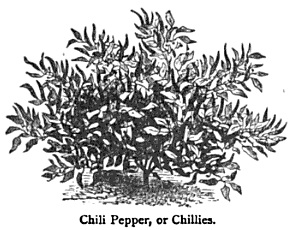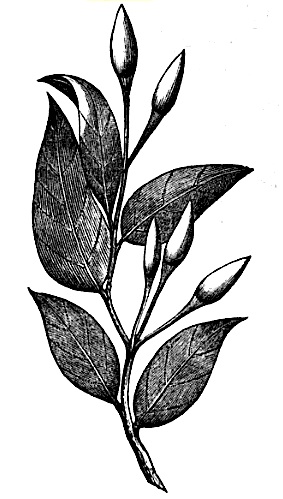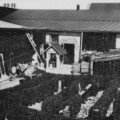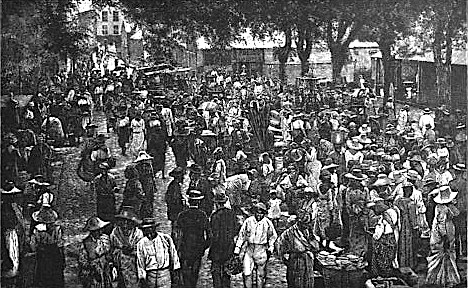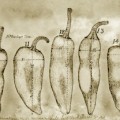Grown in the garden of the London Horticultural Society, 1832:
Chili Peppers: Yellow Tree Capsicum, Red Chile, Small Red Chile, Tree Capsicum, Piment Longue Petit Tardif, Long Chile from the East Indies, Long Chile, Long Red Chile, Black Chile, Piment Violet, Indian Small Red, Cayenne Pepper. Large Long Yellow, Piment Gros, Capsicum Paprika, Short Red, Piment Cerise, Tall Cherry Red, Small Cherry Yellow, Boston Pepper, Oval Yellow, Small Yellow, Cerise Gros, American Bonnet Pepper, Red Tomato.
From The Gardener’s Magazine and Register of Rural & Domestic Improvement, Volume 8, by John Claudius Loudon. London: Longman, Rees, Brown and Green, 1832.
From The Vegetable Garden, 1885:
In the London market gardens, Capsicums [Bell peppers] are grown in Cucumber Houses or similar places where a brisk heat and plenty of moisture are maintained. The seeds are sown in pots in April, and when large enough the young plants are potted six or eight together in an 8-inch pot in good rich soil and put on stages in a well-lighted position. Plenty of water is given them whilst growing. Some plant them out in frames, and in this way obtain abundance of fruit, but the most profitable way is pot-culture or frame-culture. A good instance of the slowness with which the use of vegetables is made known is afforded by the large green mild variety of Capsicum [bell pepper], which is so much eaten over a great part of Spain and some of the adjoining French departments. It was carried by the Spaniards into Naples during their dominion there in the sixteenth and seventeenth centuries, and has ever since remained in common use there, without spreading farther. It makes an excellent salad, having all the flavour of the Capsicum without pungency, and enters into various light and pleasant dishes of the Italian and Spanish cooks.
Common Capsicum (Piment) [Chili Pepper]. The seed-pods, green or ripe, are very much used as seasoning, especially in hot countries; they are also pickled in vinegar. When dried and ground, they form cayenne or red pepper. The pods of some of the large kinds, which are very fleshy and not hot to the taste, are used as vegetables. A great many, if not all, of the cultivated varieties of Capsicum appear to have been derived from this species, which is successfully cultivated in the climate of Paris as an annual, with the assistance of a little artificial heat at the commencement of its growth. It grows pretty tall, has leaves longer than broad, white and rather small flowers, and usually long seedpods. It appears that the acrid or burning principle in the seed-pods of this plant is in inverse proportion to their size. The large kinds are usually mild in flavour, the medium-sized sometimes mild and sometimes the reverse, while the small kinds are invariably very pungently hot to the taste.
Varieties Grown: Long Red Capsicum, Guinea Pepper, Piment Rouge Long, Long Cayenne Pepper, Purple Capsicum, Long Yellow Capsicum, Piment Violet, Cherry Pepper (Piment Cerise), Improved Bull-nose Capsicum, or Sweet Mountain Pepper (Piment Gros Carre d’Amerique), Monstrous Capsicum (Piment Monstreux), Spanish Mammoth Capsicum (Piment Doux d’Espagne), Red Tomato Capsicum, or American Bonnet Pepper (Piment Tomate), Bird’s-beak Pepper (Piment Bee d’Oiseau) or Mad Pepper (Piment Enrage) [piquins], and Bed Tomato Capsicum.
Text and illustrations from The Vegetable Garden: Illustrations, Descriptions, and Culture of the Garden Vegetables of Cold and Temperate Climates, by Vilmorin-Andrieux et cie. London: J. Murray, 1885.

